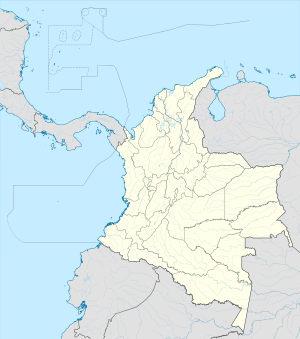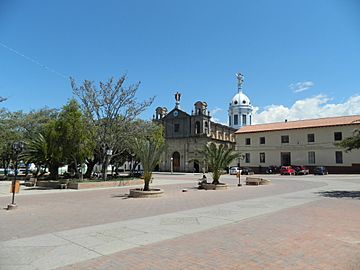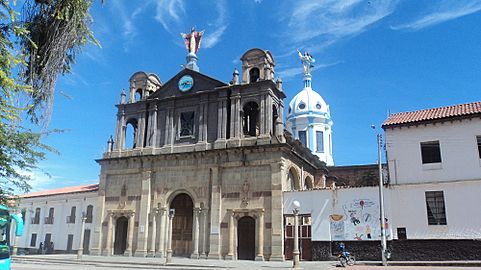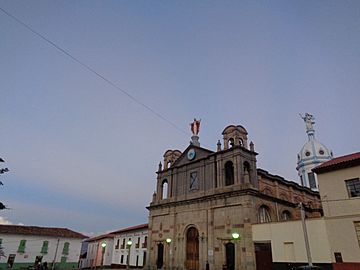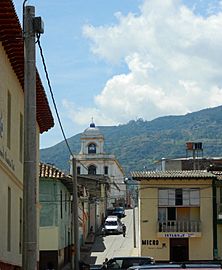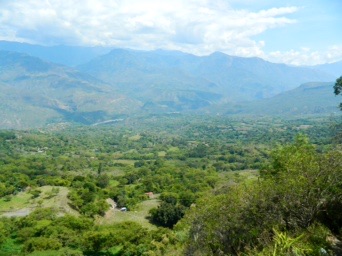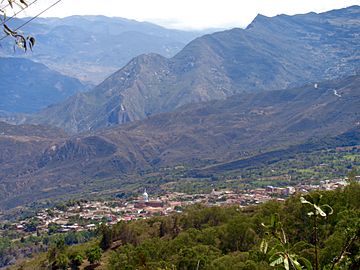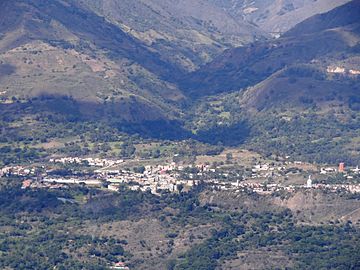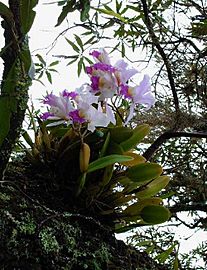Soatá facts for kids
Quick facts for kids
Soatá
|
||
|---|---|---|
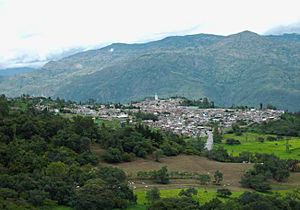
View of Soatá
|
||
|
||
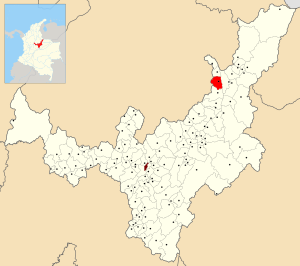
Location of the town and municipality of Soatá in Boyacá Department
|
||
| Country | ||
| Department | Boyacá | |
| Province | Northern Boyacá Province | |
| Founded | 10 December 1545 | |
| Founded by | Juan Rodríguez Parra | |
| Government | ||
| • Type | Municipality | |
| Area | ||
| • City | 136 km2 (53 sq mi) | |
| Elevation | 1,950 m (6,400 ft) | |
| Population
(2016)
|
||
| • City | 7,069 | |
| • Density | 51.98/km2 (134.6/sq mi) | |
| • Urban | 5,237 | |
Soatá is a town and municipality in Boyacá Department, Colombia. It is located on the western slopes of the Cordillera Oriental mountain range. Soatá is found at the northeast end of the Boyacá Department. It is also the capital of the Northern Boyacá Province. Soatá shares borders with several other towns. These include Boavita to the east, Tipacoque to the north, and Susacón to the south. To the west, it borders Onzaga in the Santander department.
Contents
What is the Climate Like in Soatá?
| Weather chart for
|
|||||||||||||||||||||||||||||||||||||||||||||||
|---|---|---|---|---|---|---|---|---|---|---|---|---|---|---|---|---|---|---|---|---|---|---|---|---|---|---|---|---|---|---|---|---|---|---|---|---|---|---|---|---|---|---|---|---|---|---|---|
| J | F | M | A | M | J | J | A | S | O | N | D | ||||||||||||||||||||||||||||||||||||
|
41
25
12
|
58
25
12
|
88
25
13
|
271
24
13
|
241
23
13
|
126
23
13
|
101
23
12
|
103
23
13
|
155
24
13
|
260
23
13
|
163
23
13
|
84
24
12
|
||||||||||||||||||||||||||||||||||||
| temperatures in °C precipitation totals in mm source: Climate-data.org - Soatá |
|||||||||||||||||||||||||||||||||||||||||||||||
|
Imperial conversion
|
|||||||||||||||||||||||||||||||||||||||||||||||
Soatá has a pleasant climate due to its elevation of 1,950 meters (about 6,400 feet) above sea level. The temperatures are mild throughout the year. The town experiences a good amount of rainfall, especially during certain months.
What Does the Name Soatá Mean?
The name Soatá comes from the Chibcha language. This was the language spoken by the Muisca people. In their language, Soatá means "tillage of the Sun." This suggests a connection to farming and the sun's importance.
A Brief History of Soatá
Who Lived Here Before?
Soatá was already home to people during the Herrera Period. This was a time before the Spanish arrived. When the Spanish explorers came, the area was inhabited by the Muisca. The village was part of the lands ruled by a leader called a cacique. This particular cacique was named Tundama, from the city now known as Duitama.
How Was Modern Soatá Founded?
The people living in Soatá today are a mix of different groups. They are descendants of the Muisca, Caribbean, and Choques peoples. Modern Soatá was officially founded on December 10, 1545. It was founded by a sergeant named Juan Rodríguez Parra.
People and Geography of Soatá
How Many People Live in Soatá?
In 2005, Soatá had about 8,730 residents. Most of these people (63%) lived in the town's main urban area. The remaining 47% lived in the rural areas. These rural areas are divided into eight smaller sections called veredas. Some of these veredas include Los Molinos, La Laguna, Llano Grande, El Espinal, La Chorrera, and La Costa.
Where is Soatá Located?
The main part of Soatá town is located at an elevation of 1,950 meters (about 6,400 feet) above sea level. This high location gives it a unique landscape and climate.
What is Soatá's Economy Like?
Farming and Livestock
Soatá's economy mainly relies on small-scale farming and raising animals. This is often called "subsistence" farming, meaning people grow food for themselves and their local community. Important crops grown here include sugar cane, coffee, and tobacco. Farmers also grow tomatoes, maize (corn), wheat, and barley. Fruit trees, dates, and flowers are also grown.
When it comes to animals, people in Soatá raise goats, pigs, and cows.
Local Industries and Products
Soatá has a few local industries. They produce bricks and floor tiles. People also make canvas shoes and straw hats. A popular local product is panela, which is a type of unrefined whole cane sugar. Bee honey is also produced.
The town is especially known for its delicious candies and treats. Soatá is famous for its date production. This has earned it the nickname "city of the date palm of Colombia."
Exploring Soatá: Tourism and Nature
What Can You See and Do?
Soatá has a lot to offer for visitors. It is known for its rich culture and beautiful natural places. You can enjoy the local food, which is a big part of its cultural expression.
Some popular places to visit include:
- The stunning Chicamocha Canyon
- The historic Pinzón Bridge
- A natural waterfall called El Chorro
Birdwatching in Soatá
Soatá is becoming a popular spot for people who love to watch birds. Many unique bird species that are only found in Colombia can be seen here. These include the Chestnut-bellied hummingbird, Niceforo's wren, Colombian mountain grackle, and Apical flycatcher.
Festivals and Celebrations
Soatá celebrates several important festivals throughout the year. These are great times to experience the local culture and traditions.
- Our Lady of Mount Carmel Festival: A religious festival honoring the Virgin Mary.
- Torbellino's Festival: A celebration of torbellino, a traditional Colombian folk dance and music style.
Gallery
-
View of Chicamocha Canyon
See Also
In Spanish: Soatá para niños



